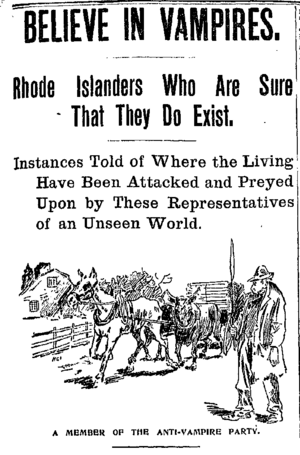New England vampire panic facts for kids
The New England vampire panic was a time in the 1800s when people in New England states like Rhode Island, Connecticut, Massachusetts, and Vermont were very scared. A disease called tuberculosis (TB) was spreading. People didn't know what caused TB back then. They thought that family members who had died from TB were somehow "draining the life" from their living relatives. To stop this, they would dig up bodies and burn certain organs. They hoped this would stop the "vampire" and the disease. Famous cases like Mercy Brown in Rhode Island and Frederick Ransom in Vermont even made national news.
Contents
What Was the "Vampire Panic"?
Understanding Tuberculosis (Consumption)
In the 1800s, tuberculosis was a very serious disease. People called it "consumption" because it seemed to "consume" or waste away a person's body. Doctors didn't know that tiny bacteria caused the illness. They also didn't know that it spread easily from person to person, especially within families.
When one family member got sick and died from consumption, others in the family often got sick too. Their health would slowly get worse. People thought this was because the dead family member was somehow taking the life force from the living. This belief was common in New England and even in parts of Europe.
How People Tried to Stop the "Vampire"
To try and protect the living, families would dig up the bodies of those who had died from consumption. They would then examine the body. If the body looked unusually fresh, or if organs like the heart still had liquid blood, people believed it was "feeding" on the living.
There were different ways people tried to stop these "attacks." Sometimes, they would just turn the body over in its grave. More often, families would burn the "fresh" organs, like the heart or liver. Then, they would rebury the body. In some rare cases, they would even cut off the head. Sick family members might also breathe in the smoke from the burned organs. Sometimes, they would even eat the ashes. They hoped these actions would cure the consumption.
What Did People Think at the Time?
Newspapers and Doubts
Not everyone believed in these "vampires." Famous writer Henry David Thoreau wrote in his journal in 1859 about a family in Vermont. He mentioned they burned organs to stop the disease. He called it a "savage" or old-fashioned belief.
When people from rural Rhode Island moved to Connecticut, some locals thought they were "uneducated." This was partly because of their beliefs in vampirism. Newspapers also didn't believe it. They called it an "old superstition" and a "curious idea."
Folk Medicine and Local Beliefs
Even though newspapers called it superstition, burning organs was seen as a type of folk medicine in some communities. In Woodstock, Vermont, many people still believed in it. Town records show that hundreds of people watched when Frederick Ransom's heart was burned. This shows how strong these local beliefs were.
What Does "Vampire" Mean Here?
It's important to know that the families involved probably didn't use the word "vampire" themselves. That word wasn't common in their communities back then. However, newspapers and people from outside the area used the term. They did this because it sounded similar to old vampire stories from Eastern Europe.
These beliefs were very different from the vampires you see in movies or books today. A researcher named Michael Bell studied this topic in New England. He said that there are no true stories of bodies actually leaving their graves to drink blood. He also found little proof that people involved in these practices called it "vampirism." The term "vampire" was mostly used by newspapers to describe the strange practice.


